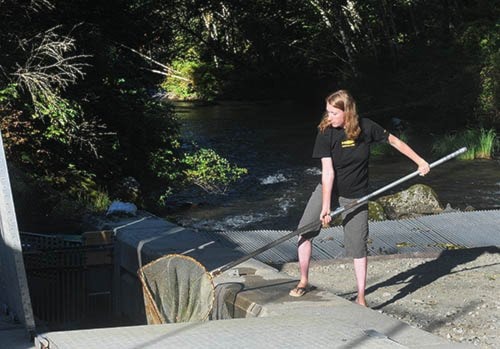They must be out there, somewhere. Somewhere in the South Alouette River sockanee are skulking about, hiding where it’s cold and dark, and waiting until the river cools down, when they can make a run to the Alouette reservoir, where they can spawn and complete their life cycle.
Usually, by this time, they’ve already done so.
August long weekend is when the new run usually peaks, when about 50 sockanee return to the Allco hatchery or the base of the Alouette dam.
But so far this year, only seven have shown up.
“We’re not concerned. We’re just doing our job, keeping our record of when they come back,” said Amanda Crowston, special projects manager with the Alouette River Management Society.
“We’ve heard from residents that they’ve been spotted holding in other places in the river.”
It could be the sockanee are just waiting for the fall rains and cooler temperatures which makes it easier to swim and spawn.
The fish are actually sockeye but are nicknamed sockanee because they used to be considered kokanee, landlocked in the Alouette reservoir by the B.C. Hydro dam for 88 years.
Then in 2005,some adventurous kokanee made a run for it, and swam over the top of the dam, when the society was studying a release of coho salmon over the top of the dam.
Those kokanee returned to spawn, were confirmed as part of the Alouette system and were nicknamed sockanee.
Now, only a year remains in a seven-year study of the river. A report based on the data will be used to present a business case to B.C. Hydro for construction of a fish ladder, about a $3-million project.
While a ladder will allow sockeye to return to the lake and spawn, re-establishing an age-old connection between the river and the reservoir, will benefit all species including coho, chinook and pink salmon.
“Really, it is about the overall watershed health and support for the salmon,” said Crowston.
In the meantime though, the river society depends on staff and inmates from Fraser Regional Correctional Centre to provide the manpower and vehicles to trap the sockeye at the hatchery, then truck them around the dam, for speedy release into the reservoir.
“Without their commitment, these sockeye would not make it. They’re the people on the ground that make it happen,” Crowston said.
Eventually, the goal is to rebuild the run to about 250,000, a healthy addition to the overall Fraser River sockeye run.
But with only 50 returning each year, that target is a long way off and which is why the Alouette River system is closed to any sockeye fishing. “We’re trying to rebuild a run and we cannot do this if people are fishing illegally.”
Crowston said the rest of the sockeye could return anytime in the next month. This is a warm, dry summer raising river temperatures.
This year’s sockeye run are also the descendents of the disastrously low run of 2009, which triggered the Cohen Commission inquiry into the Fraser River sockeye.
Most years, the sockeye have returned by the first week of September.
“One year, we’ve had them as late as October.” The rain will return, she added.
